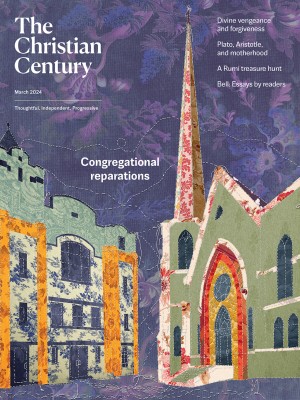March 24, Palm Sunday B (Mark 11:1–11)
Jesus moves in the same direction as other pilgrims but at a pace and purpose that is his own.
What I remember is like a dream. I was visiting a friend years ago, around the time of an important saint’s day in her country, and her family decided that we would go to the saint’s shrine to see the festivities honoring her. We piled into their car after a hasty dinner and joined others streaming toward the basilica. The drive would have taken less than an hour any other day, but night fell around us and hours passed as traffic moved at a glacial crawl. Eventually we gave up, somehow found a way to turn around, and went home.
But I don’t remember that part. I have only a partial, fever-dream memory of our car moving in slow motion through the dark, headlights illuminating crowds of pilgrims on bicycles or walking, everything and everyone pulled in one direction like snowmelt coursing downhill.
Read our latest issue or browse back issues.
I imagine that same kind of gravitational pull moving waves of pilgrims along the roads into Jerusalem for the festival of Passover, all surging into the city, through its crowded streets, toward the Temple Mount.
Jesus, too, is drawn to Jerusalem. In Mark, Jesus moves steadily south out of Galilee for a chapter or two before he announces that’s where he’s headed. When the disciples learn that Jesus is leading them to Jerusalem, they are amazed and afraid (10:32).
I imagine some pilgrims picking up their pace for the last miles of the journey, their excitement and urgency increasing as they near their destination. But just where others might speed up, when Jesus reaches the outskirts of Jerusalem, he pauses. Mark also slows the pace of the story for a moment to describe Jesus’ careful preparations to enter the city and the responses of pilgrims who meet Jesus as he rides through the crowds on a borrowed donkey. It is a short passage that is rich in detail and symbolism.
But soon the story speeds back up again. Mark reports Jesus’ first visit to the temple that day in a single sentence: “Then he entered Jerusalem and went into the temple; and when he had looked around at everything, as it was already late, he went out to Bethany with the twelve.”
Jesus returns to the temple again and again over the coming days, and Mark tells us plenty about who he meets and what he does and says then. But I wonder about Jesus’ first visit to the temple, on the day we call Palm Sunday.
After a long journey and his carefully planned parade, Jesus presses on through the packed streets to reach the Temple Mount. The steps up to the temple and its outer courts were surely a rumble of many bodies moving and jostling, many voices praying, singing, and shouting, a vibrant collage of sights and sounds and smells of devout pilgrims from many cultures and places drawn together to celebrate the “feast of freedom.” Arriving there, a long-desired destination for so many pilgrims, what did Jesus see as he “looked around at everything”? What did Jesus do?
In November, Sharon Brous went on Ezra Klein’s podcast and talked about a 2,000-year-old Mishnah that instructs pilgrims on their visit to the temple in Jerusalem. After climbing up the steps to the Temple Mount, they would come to an arched entryway, pass through it into a courtyard, and turn either right or left. The usual pattern was to turn to the right, move around the edges of the courtyard, then exit the way they came in. But there were different instructions for pilgrims arriving at the temple “brokenhearted.” These pilgrims climbed the stairs like all the others and passed under the same arch, but they were to turn left to begin their circle around the courtyard.
When these pilgrims traveling in opposite directions inevitably met, the person coming from the right was to ask, “What has happened to you?” And the brokenhearted one was to share the reason for their sorrow. After listening, the pilgrim from the right was to give a blessing to the person who had told their story, then each continued on their way.
Could this Mishnah have shaped practices in the temple at the time Jesus was there? Throughout Mark’s story, as Jesus moves toward Jerusalem, he travels in the same direction as other pilgrims but moves at a pace and purpose that is his own. So it is easy to imagine him stepping into the halting rhythm of holy lament and holy listening the Mishnah describes, while the frantic buzz and flurry and tension of the Passover festival swirls around him.
And what about us? Are we moving as if in a dream, carried along half awake at the pace of the pilgrims traveling in more or less the same direction as we are? Can we step out of the stream and pause, either to meet the brokenhearted ones in our communities, to bear witness to their sorrows, or to share our own heartbreak? Amid the buzz and flurry and tension of our time, can we too step into a different rhythm and follow in the way of Jesus, moving at his pace of compassion and love?





